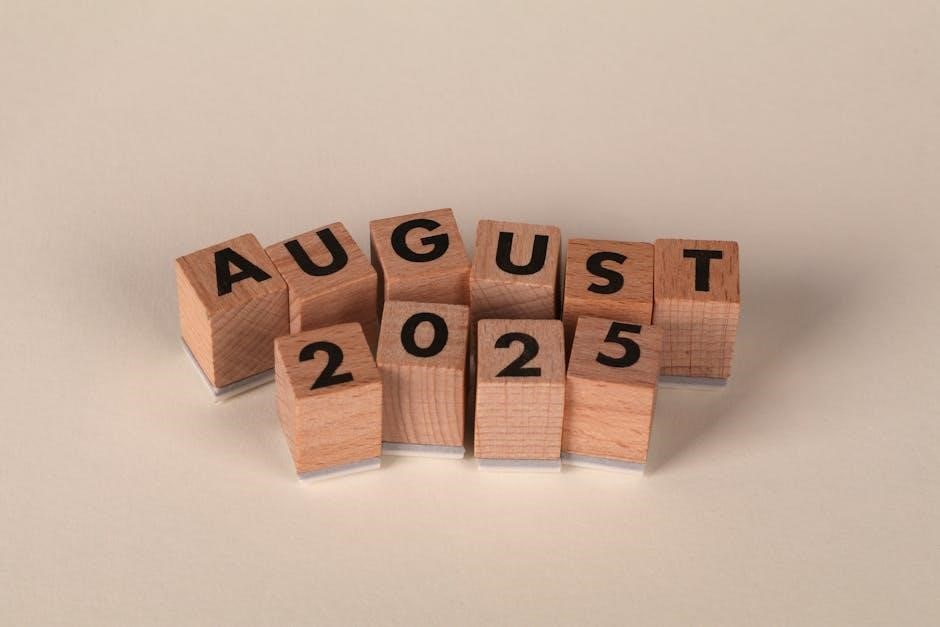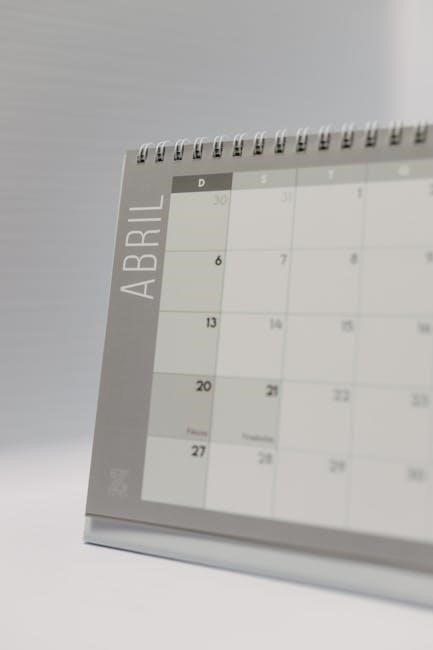The 2023 Liturgical Calendar, published by the US Conference of Catholic Bishops, guides worship planning and spiritual observance. It begins with Advent on November 27, 2022, and concludes on December 2, 2023, structuring the Church year around key seasons, solemnities, and feasts. This calendar is essential for parishes and individuals to align their worship with the Church’s traditions and rhythms, fostering a deeper connection to the liturgical life of the Catholic faith. Its detailed structure includes liturgical colors, lectionary citations, and holy days, making it a vital resource for liturgical preparation and devotion.
1.1 Overview of the Liturgical Year 2023
The 2023 Liturgical Year commenced on the First Sunday of Advent, November 27, 2022, and concludes on December 2, 2023. It is structured around key seasons: Advent, Christmas, Lent, Easter, and Ordinary Time. The year emphasizes solemnities, holy days, and moveable feasts, such as the Nativity of Our Lord on December 25. Liturgical colors, like purple for Advent and Lent, and white for Christmas, reflect the spiritual themes of each season. The lectionary cycles for 2023 include Sunday Year A and Weekday Cycle I, guiding scripture readings. This structure helps Catholics deepen their faith through prayer, reflection, and communal worship, aligning daily life with the Church’s liturgical rhythms.
1.2 Importance of the Liturgical Calendar in Worship Planning
The liturgical calendar is indispensable for worship planning, providing a structured framework for spiritual observance. It ensures consistency and unity across parishes, aligning celebrations with universal Church traditions. By outlining solemnities, feasts, and liturgical colors, it aids in preparing meaningful liturgies that reflect the Church’s theological and spiritual priorities. The calendar also guides the selection of scripture readings, ensuring a balanced and comprehensive encounter with God’s Word. For worship planners, it serves as a vital tool to coordinate music, prayers, and rituals, fostering a cohesive and enriching worship experience. Its importance lies in its ability to connect the local church to the global Catholic community, ensuring a unified celebration of faith.
Key Features of the 2023 Liturgical Calendar
The 2023 Liturgical Calendar includes liturgical colors, lectionary cycles, and principal celebrations. It outlines moveable feasts, solemnities, and holy days, ensuring a structured approach to worship throughout the year.
2.1 Structure of the Liturgical Year
The 2023 Liturgical Year is structured around key seasons: Advent, Christmas, Lent, Easter, and Ordinary Time. It begins on November 27, 2022, with the First Sunday of Advent and concludes on December 2, 2023. The year is divided into cycles, with Sunday readings following Year A and weekday readings using Cycle I. Liturgical colors, such as purple for Advent and Lent, and white for Christmas and Easter, reflect the spiritual significance of each season. The structure ensures a balanced focus on preparation, celebration, and ordinary time, guiding the faithful through a meaningful spiritual journey. This framework aids in worship planning and devotion.
2.2 Principal Celebrations and Moveable Feasts
The 2023 Liturgical Calendar highlights principal celebrations and moveable feasts. Solemnities like Mary, Mother of God (January 1) and the Epiphany of the Lord (January 6) are key events. The Epiphany is transferred to Sunday, January 8, in many dioceses. The Ascension of the Lord, typically on a Thursday, is celebrated on May 21, 2023. Easter, the pinnacle of the liturgical year, falls on April 9, influencing moveable feasts such as Ash Wednesday (February 22). These celebrations are central to the liturgical cycle, emphasizing significant moments in the life of Christ and the Church, and are vital for worship planning and spiritual reflection throughout the year.
2.3 Liturgical Colors and Their Significance
Liturgical colors play a vital role in the 2023 calendar, symbolizing spiritual themes and guiding worship. Purple signifies repentance and royalty, used in Advent and Lent. White represents joy and purity, marking Christmas, Easter, and solemnities like the Nativity of Our Lord. Red denotes the Holy Spirit and martyrdom, seen on Pentecost and feasts of martyrs. Green symbolizes growth and hope, predominant in Ordinary Time. Gold or white is reserved for solemnities, emphasizing their importance. These colors create a visual rhythm, deepening the spiritual experience and connecting the faithful to the liturgical journey throughout the year, as outlined by the US Conference of Catholic Bishops and the Roman Missal.

Liturgical Seasons in 2023
The 2023 liturgical year includes Advent (Nov 27, 2022–Dec 24, 2022), Christmas (Dec 25, 2022–Jan 8, 2023), Lent (Feb 22–Apr 8, 2023), Easter (Apr 9–May 28, 2023), and Ordinary Time, divided into two periods (Jan 9–Feb 21, 2023, and May 29–Dec 2, 2023). These seasons reflect the life of Christ and guide spiritual reflection throughout the year.
3.1 Advent 2022-2023
Advent 2022-2023 began on November 27, 2022, and concluded on December 24, 2022, marking the start of the 2023 liturgical year; This season is a period of preparation for Christmas, focusing on hope, repentance, and joy. It comprises four Sundays, with each week emphasizing spiritual readiness for the coming of Christ. The liturgical color is purple, symbolizing penance, except for the third Sunday (Gaudete Sunday), which uses rose to signify joy. Key feasts include St. Andrew on November 30 and the Immaculate Conception on December 8. Advent’s prayers and readings highlight anticipation and renewal, preparing believers for the Nativity of the Lord.
3.2 Christmas Season 2022-2023
The Christmas Season 2022-2023 began on December 25, 2022, and concluded on January 8, 2023, with the Feast of the Epiphany. This period includes the Octave of Christmas, from December 25 to January 1, celebrating the Nativity of the Lord. Key solemnities within this season are the Holy Family on December 30 and Mary, Mother of God on January 1. The liturgical color is white, symbolizing purity and joy. The Epiphany, marking the visit of the Magi, was celebrated on January 6, 2023, but in most dioceses, it was transferred to the following Sunday, January 8. This season emphasizes the mystery of the Incarnation and its significance in Christian faith.
3.3 Lent and Easter 2023
Lent 2023 began on Ash Wednesday, February 22, and concluded on Holy Thursday, April 6. The Easter Triduum, spanning April 6-9, included Holy Thursday, Good Friday, and Easter Sunday. Easter Sunday, the resurrection of Christ, was celebrated on April 9, 2023. The liturgical color shifted from purple during Lent to white for Easter, symbolizing joy and new life. The Ascension of the Lord, typically on the 40th day after Easter, was transferred to May 21, 2023. This period is a time of spiritual renewal, reflection, and celebration of Christ’s sacrifice and resurrection, central to the Christian faith.
3.4 Ordinary Time 2023
Ordinary Time 2023 began after Easter on April 10, 2023, and concluded on November 25, 2023, prior to Advent. This period is divided into two parts: after Easter and before Advent. It focuses on the life and mission of Jesus, emphasizing discipleship and spiritual growth. The liturgical color is green, symbolizing hope and growth. Key Solemnities include the Most Holy Trinity (May 28, 2023) and the Most Sacred Heart of Jesus (June 16, 2023). Optional memorials and weekdays highlight saints and biblical themes, with readings reflecting the Church’s mission and daily Christian living, fostering a deeper connection to faith and community.

Holy Days of Obligation and Solemnities
Holy Days of Obligation and Solemnities in 2023 include Mary, Mother of God (January 1), Epiphany (January 6), Ascension (May 21), and Nativity of Our Lord (December 25), essential for worship and spiritual reflection.
4.1 Mary, Mother of God (January 1, 2023)
The Solemnity of Mary, Mother of God, celebrated on January 1, 2023, is a Holy Day of Obligation. It honors the divine maternity of the Blessed Virgin Mary and her role in the mystery of salvation. This feast, rooted in Scripture and tradition, is a fitting way to begin the new year, reflecting on Mary’s faith and motherhood. The liturgical color is white, symbolizing purity and joy. This celebration is integral to the Christmas season, emphasizing the unity of the Holy Family and the gift of life. It invites believers to deepen their devotion to Mary and her intercessory role in the Church.
4.2 The Epiphany of the Lord (January 6, 2023)
The Epiphany of the Lord, celebrated on January 6, 2023, commemorates the visit of the Magi to the infant Jesus, symbolizing the revelation of Christ to the Gentiles. In many dioceses, this solemnity is transferred to the following Sunday, January 8, 2023, to accommodate worship schedules. The liturgical color is white, representing light and divine revelation. This feast highlights the universal mission of the Church and the unity of all peoples in worshiping the Messiah. It marks the end of the Christmas season, transitioning into Ordinary Time, and invites believers to reflect on the light of Christ illuminating all nations. This celebration is a Holy Day of Obligation in some regions.
4.3 The Ascension of the Lord (May 21, 2023)
The Ascension of the Lord, celebrated on May 21, 2023, marks the 40th day after Easter and the Seventh Sunday of Easter. This solemnity commemorates Jesus Christ’s ascent into heaven, as described in Acts 1:1-11, signifying the culmination of his earthly mission. The liturgical color is white, symbolizing joy and divine glory. In 2023, the Ascension is transferred to the following Sunday in most dioceses, ensuring broader participation. It is a Holy Day of Obligation in some regions, emphasizing its importance. The feast bridges Easter and Pentecost, reminding believers of Christ’s promise to send the Holy Spirit. This celebration invites reflection on the divine plan and the Church’s mission to share the Gospel worldwide.
4.4 The Nativity of Our Lord (December 25, 2023)
The Nativity of Our Lord, celebrated on December 25, 2023, is a solemnity and a Holy Day of Obligation. It commemorates the birth of Jesus Christ, embodying the core of Christian faith. The liturgical color is white, symbolizing purity and joy. This feast is central to the Christmas season, marking the first day of the Octave of Christmas. Anticipatory Masses before 4:00 PM do not fulfill the Holy Day obligation. The readings and liturgical rites focus on the Incarnation, emphasizing God’s love and redemption. This day is a pivotal moment for reflection, worship, and celebration of the gift of salvation through Jesus’ birth. It is a time for spiritual renewal and communal rejoicing.

Lectionary and Liturgical Readings
The 2023 liturgical calendar includes lectionary readings for Sundays and weekdays, guiding worship through Year A of the Sunday cycle and Cycle I for weekdays, providing a structured approach to scripture throughout the year.
5.1 Sunday Lectionary Cycle (Year A)
The Sunday Lectionary Cycle for 2023 follows Year A, which emphasizes the Gospel of Matthew, complemented by readings from Mark, Luke, and John. This cycle begins on the First Sunday of Advent, November 27, 2022, and concludes on the Solemnity of Christ the King, November 26, 2023. The readings are carefully selected to provide a balanced and cohesive narrative of salvation history, ensuring that the faithful encounter key doctrines and stories central to Christian faith. Year A also includes selections from the Old Testament, Psalms, and Epistles, fostering a rich and unified worship experience across Catholic communities worldwide.
5.2 Weekday Lectionary Cycle (Cycle I)
The Sunday Lectionary Cycle for 2023 follows Year A, emphasizing the Gospel of Matthew. It begins on the First Sunday of Advent, November 27, 2022, and concludes on Christ the King Sunday, November 26, 2023. This cycle includes readings from the Old Testament, Psalms, Epistles, and Gospels, providing a cohesive narrative of salvation history. Year A highlights key events like the Temptation of Jesus, the Sermon on the Mount, and the Resurrection narratives, fostering a deep understanding of Christian doctrine. The readings are carefully selected to enrich worship and guide the faithful through the liturgical year.

Liturgical Resources and Downloads
The 2023 Liturgical Calendar is available as a PDF from the USCCB, detailing daily celebrations, liturgical colors, and lectionary readings, essential for worship planning and resources.
6.1 Availability of the 2023 Liturgical Calendar in PDF Format
The 2023 Liturgical Calendar is widely available in PDF format, published by the United States Conference of Catholic Bishops (USCCB). This document provides a comprehensive overview of the liturgical year, including daily celebrations, liturgical colors, and lectionary citations. It is an essential resource for parishes, liturgical planners, and individuals seeking to align their worship with the Church’s traditions. The PDF format ensures easy access and readability, making it a convenient tool for spiritual preparation and planning. Additionally, the calendar is often available for download from diocesan websites and liturgical resource providers, ensuring broad accessibility for all who seek to deepen their faith through the liturgical cycle.
6.2 Sources for Downloading the Liturgical Calendar
The 2023 Liturgical Calendar in PDF format can be downloaded from various reliable sources. The United States Conference of Catholic Bishops (USCCB) officially publishes the calendar, making it available on their website. Additionally, many diocesan websites offer free downloads tailored to their specific liturgical needs. Liturgical resource websites and Catholic publishers also provide access to the PDF version, ensuring widespread availability. Users can easily search for “2023 Liturgical Calendar PDF” to find multiple sources, including the USCCB website and other trusted religious institutions, making it convenient to access and utilize this essential liturgical planning tool.
The 2023 Liturgical Calendar serves as a vital guide for worship, reflection, and spiritual growth, uniting the faithful in shared traditions and sacred rhythms throughout the year.
7.1 Summary of the Liturgical Calendar’s Role in 2023
The 2023 Liturgical Calendar played a pivotal role in guiding Catholic worship and spiritual life, structuring the year into seasons, solemnities, and feasts. It provided essential details for each day, including liturgical colors, readings, and holy days, aiding parishes and individuals in aligning their devotion with the Church’s traditions. By outlining key celebrations and observances, the calendar fostered a sense of community and spiritual unity, while its availability in PDF formats ensured accessibility for planning and reflection. Its comprehensive structure supported liturgical preparation, making it an indispensable resource for deepening faith and practicing the liturgy faithfully throughout the year.
7.2 Final Thoughts on the Importance of the Liturgical Calendar
The 2023 Liturgical Calendar is a cornerstone of Catholic worship, offering a structured framework for spiritual life. It unifies the faithful worldwide, providing clarity on seasons, solemnities, and feast days. By detailing liturgical colors and readings, it enriches liturgical preparation and devotion. The availability of the calendar in PDF formats ensures accessibility for parishes and individuals, facilitating prayer and reflection. Ultimately, the liturgical calendar deepens faith and fosters a sense of community, guiding believers through the Church’s rhythms and traditions. Its importance lies in its ability to connect the faithful to the divine, enhancing their spiritual journey throughout the year;
